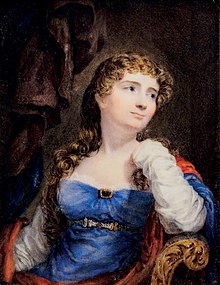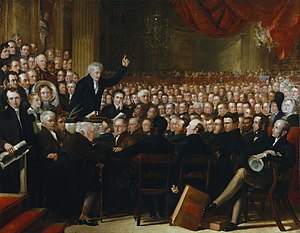Lady Byron

Anne Isabella Noel Byron, 11th Baroness Wentworth and Baroness Byron (17 May 1792 – 16 May 1860) was the wife of George Gordon Byron, 6th Baron Byron, the poet; and mother of Ada, Countess Lovelace, the patron and co-worker of mathematician Charles Babbage.
Name
Her names were unusually complex. She was born in London as Anne Isabella Milbanke, the only child of Sir Ralph Milbanke, 6th Baronet, and his wife the Hon. Lady [Judith] Milbanke, sister of Thomas Noel, Lord Wentworth. When Lord Wentworth died, a few months after Anne Isabella's marriage to Lord Byron, her father, who inherited a large part of the estate, changed his name to Sir Ralph Noel. When her mother died, Anne Isabella and her husband changed their names to Noel also. This was a condition of inheritance. Her mother had written a letter to the Prince Regent, requesting that he make her daughter "Lady Wentworth" so her parents would not have to call her "Byron".
So she was first Anne Isabella, Baroness Byron or Lady Byron, and then Anne Isabella Noel, Baroness Byron. Her uncle had been both Viscount and Baron Wentworth, which titles were inherited differently: the viscounty became extinct, and the barony fell into abeyance between her mother and her cousin Nathaniel Curzon, 3rd Baron Scarsdale. When Curzon died without heirs in 1856, Baroness Byron became Baroness Wentworth, in her own right, as sole claimant; but she did not use the title. She signed her letters "A. I. Noel Byron" and her will as "Baroness Noel-Byron". The world knew her as "Lady Byron", and her friends called her by the nickname "Annabella".
Youth
She was a gifted child. To cultivate her obvious intelligence, her parents hired as tutor a former Cambridge University professor by the name of William Frend. Under his direction, Annabella's education proceeded much like that of a Cambridge student; her studies involved classical literature, philosophy, science and mathematics, in which she particularly delighted. This fascination led her husband Lord Byron to nickname her his "princess of parallelograms".
Anne Isabella developed into a stiff, religious woman with strict morals. She was aware of her strong intellect and was not ashamed to demonstrate it in her social realm. Often described as cold and prim, she seemed an unlikely match for the man who would become her ultimate obsession, the dramatically dark and "morally fractured" poet Lord Byron. Their first meeting occurred in March 1812. She later said to her mother that though she would not venture to introduce herself to Byron, she would certainly accept his introduction if it were offered.
Although Byron's popularity was soaring following the success of his work Childe Harold's Pilgrimage, Annabella continually rejected his attentions. Spurned, Byron committed himself to the pursuit of her and in October 1812, he proposed marriage. In response, Annabella wrote a summary of his character and three days later refused him. However, both were plagued with a persistent interest in one another.
In August 1813, she contacted Byron in writing for the first time. The letters continued into the next year, some offering reassurance and support during times when public opinion of him was not favorable, others describing the "imperfect attachment" she felt for him. During this time, he accepted an invitation from Sir Ralph Milbanke to visit Seaham Hall, the family home in County Durham.
Marriage
When Lord Byron proposed a second time to Miss Milbanke in September 1814, she accepted. The couple were married privately, and by special license, at Seaham Hall in County Durham on January 2, 1815 (the officiating clergyman was her illegitimate cousin, the Rev. Thomas Noel of Kirkby Mallory, natural son of her uncle, Viscount Wentworth.) The couple lived at Piccadilly Terrace in London.
Byron was then in extreme financial distress. He rejected payments offered for his written works, as he believed the sums were insufficient. He was having difficulty selling his estates at Newstead Abbey and Rochdale to clear his debt. During the summer of 1815, he began to unleash his anger and hostility on his wife. His moods were dark and he began to drink heavily. In a letter to his half-sister, Augusta Leigh, he stated his suspicions that his wife had broken the lock on his desk and searched it. Later in the year he began an affair with Susan Boyce, a London chorus girl.
Lady Byron became increasingly upset. In the late stages of pregnancy, she feared Byron may have been going mad. In November 1815, she wrote to Leigh and told her of Byron's moods and behavior. In answer to her sister-in-law's letter, Leigh traveled to the Byrons' home to assist. Upon her arrival, she became the subject of Byron's wrath and believed him to be temporarily insane. On December 10, Lady Byron gave birth to the couple's only child, a daughter whom they named Ada. Byron's despair seemed to increase.
Separation
In January 1816, as the Byrons passed their first anniversary, Lord Byron suggested they sell the house at Piccadilly Terrace. He recommended that Lady Byron take Ada to her parents' home and stay there temporarily until he settled their finances. In disbelief, Annabella sought medical advice as she had become convinced her husband had gone mad. She invited a physician to their home to assess Byron. Byron was unaware of the true purpose for the visit. The doctor recommended she do as Byron requested and relocate to her parents' estate.
Lady Byron began a detailed documentation of Byron's behavior, moods, and speech. She contacted his solicitor and friend, John Hanson, and told him her concerns that Byron would take his life. She also provided Hanson with a pamphlet on hydrocephalus, accompanied by notes that suggested Byron could be suffering from this particular affliction. Following this conversation, Lady Byron took Ada and traveled to her parents' residence at Kirkby Mallory in Leicestershire. She would not see Byron again.
Later life
During her first month at Kirkby Mallory, Lady Byron wrote to Byron affectionately, addressing him as "dearest Duck". Her mother wrote to him and invited him to come to their home. However, her concern for Lady Byron soon became paramount, and her parents sought legal counsel. Their attorney recommended a legal separation and sent a letter proposing the separation to Byron. Augusta, who had remained with Byron at Piccadilly Terrace since his wife's departure, intercepted the letter, as she feared Byron would commit suicide if he knew of it. She returned the letter to Kirkby Mallory and communicated her opinion that greater consideration should be taken in the matter of the Byrons' marriage. A week later, however, a messenger sent Byron the proposal again.

This time it reached him but he refused to believe Lady Byron no longer wanted to be married to him. He asked Augusta to write to her; in addition, he refused to dissolve their marriage. A short while later, when Lady Byron made clear her suspicions that Byron's relationship with his half-sister Augusta was incestuous, he changed his mind. He agreed to grant Lady Byron's request if she proved that the request for legal separation was truly hers and not that of her parents. In response, Lady Byron personally communicated her feelings to Leigh. Byron kept his word, and their separation was made legal in March 1816, in a private settlement.
Following the settlement, Leigh wrote to Lady Byron; the latter's solicitor replied to the private note. Byron was enraged by such cold treatment of his half-sister. Soon after the dissolution of his marriage, he left England and lived the remainder of his days abroad.
Though she wished to separate from Byron, Lady Byron was haunted by him until her death. She had tried hard to save his soul and secure him a place in Heaven. In the years following their separation, she came to believe that the time she had spent with Byron guaranteed he would experience God's embrace upon his death. She kept his letters, copies of her own to him, and letters about him. She carefully documented their relationship, supposedly in preparation for any challenge Byron may have made for custody of Ada.
He never did seek custody of his daughter, though he sent for both of them shortly before his death in Greece on April 19, 1824. Lady Byron was gratified by his final gesture.[citation needed] Her obsession with Byron did not end with his death. Ultimately her relationship with Byron defined her life, though she committed herself to social causes, such as prison reform and the abolition of slavery. In furtherance of the latter, Baroness Byron attended the 1840 World Anti-Slavery Conference, where she was one of the few women included in its commemorative painting.[1][2]
Daughter
As Ada grew, Lady Byron feared she might inherit Byron's behaviors and dark moods. She schooled Ada in science and mathematics and discouraged literary study. Though her effort was great, it eventually seemed in vain. Ada embodied many of her father's rebellious qualities.
She married at nineteen years of age, had three children, and amassed considerable gambling debt before dying from cancer on November 27, 1852. Lady Byron attended her daughter's deathbed, where she refused her opiates, on the grounds that they would cloud her mind too much for repentance. Ada was thirty-six years old when she died, just as Byron had been.
Death
Lady Byron died of breast cancer on May 16, 1860, the day before her 68th birthday. She was buried in Kensal Green Cemetery at Kensal Green in London. Prior to her death, she shared the story of her marriage to Byron with Harriet Beecher Stowe, who published the account in 1869. In the event, she all but destroyed Lord Byron's reputation. It was the first time anyone had published suspicions of an incestuous relationship between Byron and his half-sister.
Lady Byron's barony passed to her grandson Byron King-Noel, Viscount Ockham.
References
- ^ The Anti-Slavery Society Convention, 1840, Benjamin Robert Haydon, accessed 19 July 2008
- ^ The others were Elizabeth Pease, Amelia Opie, Anne Knight, Mary Anne Rawson, Mrs John Beaumont, Elizabeth Tredgold, Thomas Clarkson's daughter Mary and right at the back Lucretia Mott.
Bibliography
- Lodge, Edmund, Norroy King of Arms, The Peerage of the British Empire, London, 1858, p. 588, under 'Anne Isabella Noel-Byon, Baroness Wentworth of Nettlested.'
